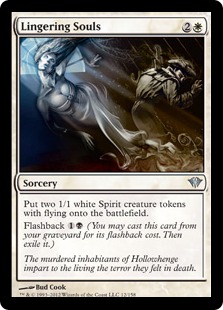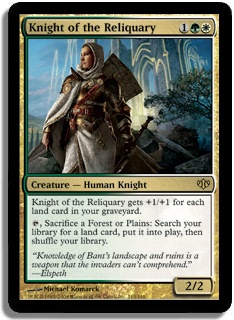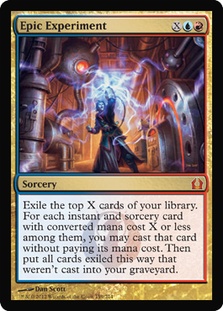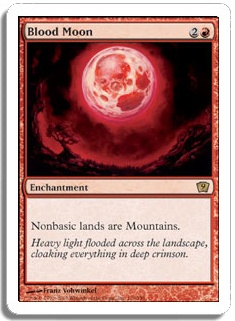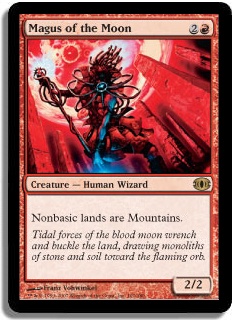With three major events in a few short weeks, Modern received a boost and is gearing up for its second PTQ season. So brace yourself: winter is coming, and the battles will be tough.
The most important news of this past weekend was the next level of all the good cards in a single deck: Lingering Souls in Jund. Anyone remember a good blue card to put there? Okay, as Snapcaster Mage isn’t really good to cascade into, I know what I’ll build when Jace, the Mind Sculptor is unbanned. By adopting Lingering Souls, Jund gained some much-needed reach to fight cards like Restoration Angel, a Cranial Plated Ornithopter, and Infect creatures. Jund unfortunately has no way to pump these tokens, but their value and influence on major matchups is probably high enough to justify splashing the fourth color.
But, honestly, is this splash a next level technology or an attempt to adapt to a hostile environment? Jund has versatile cards but still lacks focus, relying on brute force instead. In contrast to other similar decks (like Gifts Rock), Jund has almost no problem the drawing proper half of its deck in the right matchups, but this versatility has a dark side. The deck has no real ways to improve its matchups post-board aside from paranoid hate (which isn’t affordable in such a diverse format). Even Infect, the deck that’s supposed to die to removal, is in fact about 45-55 against Jund.
While reading Marijn Lybaert primer about Infect, I noticed he said the following:
“Just to make sure you know how to play around Lightning Bolt: play a land and cast Might of Old Krosa first! If they let it resolve, you’ve got yourself a 5/5 now, and you can cast your Groundswell. If they respond by Bolting, you can just play your Groundswell in response.”
“…opponent who was running Piracy Charm in his U/W Midrange deck. Unfortunately it didn’t really work out for him, as I just cast Mutagenic Growth in response to his +2/-1, giving myself a nice +4/+1.”
Does the word “instant” in the card type forbid casting the spell in your own turn? Infect players are good at playing around removal, and if your opponent casts pump spell directly into your open mana, you should know that they either have a way to beat you or are hopeless. Pump spells taking care of removal, both damage dealing and directly killing (Vines of Vastwood), are an essential part of Infect’s strategy, so why not just split their value? Infect is without doubt a good deck, but this is no reason to give its players free wins. The only creature really requiring instant speed removal is Inkmoth Nexus, while the other case is when the opponent has enough cards in hand to protect the creature during your turn and then still pump it to win. Infect doesn’t always have it, especially if its pilot mulliganed.
The next big news is Wilt-Leaf Liege. The mighty Elf was first noticed in Lucas Blohon’s hate bears deck, but it quickly became a heart of the interesting “other good cards” deck driven by Baneslayer Angel. The combination of Wilt-Leaf Liege, Loxodon Smiter, and Obstinate Baloth make Liliana of the Veil pretty miserable and, accompanied by Gavony Township and exalted triggers, outclasses nearly all Jund’s creatures.
Interesting, Brian Kibler Junk deck correctly omitted his own Tamogoyf. Why? Because it’s just going to be 1/2 or 2/3, even without the help of Deathrite Shaman. If you watch Brian’s feature match against LSV, you’ll see almighty 0/1 creature for two mana certainly not worth the mana investment. Moreover, the existence of Deathrite Shaman forced Brian to exclude one of the most powerful three-mana creatures from his deck. Knight of the Reliquary used to be a huge threat, but lands are so rare in graveyards these days that the Knight often dies to Lightning Bolt. She’s still great at fetching various utility lands, but is it enough? Probably not, even though I like this card very much.
Are there ways to realize Knight of the Reliquary’s potential? I hope so. During the best days of Jund, one of its primary rivals was Mythic. Mythic relied on an extreme amount of mana acceleration and was able to put threats into play very fast. It could be too straightforward, but Jund usually has no ways to beat Iona, Shield of Emeria set for black. The same is true for Infect and green and Strom and Red; Affinity doesn’t rely on colored cards, but I guess Elesh Norn, Grand Cenobite would take care of it.
Creatures (27)
- 4 Birds of Paradise
- 4 Noble Hierarch
- 4 Knight of the Reliquary
- 4 Baneslayer Angel
- 3 Iona, Shield of Emeria
- 4 Lotus Cobra
- 4 Thalia, Guardian of Thraben
Lands (26)
Spells (7)

With sixteen mana accelerators, you could play Baneslayer Angel as fast as turn 3, while the combination of Lotus Cobra and Knight of the Reliquary could allow you to play Iona, Shield of Emeria by the third turn as well. Technically, neither of these things wins the game on the spot, but if any of your cards is left unanswered for a turn or two, you’d be in the very good shape.
The old school Standard Mythic deck was 27 lands and 33 permanents, but that’s just impossible in a world with Infect, so Path to Exile made the cut with the sweet Bant Charm in the board. Summoning Trap and Cavern of Souls (found by Knight of the Reliquary, set for Angels) help your way through U/W decks and find missing threat against non-blue ones. Thalia, Guardian of Thraben also doesn’t contribute to the mana acceleration game plan, but she’s the best way to hurt you opponent right now. In other circumstances, this spot could be taken by Qasali Pridemage, Kitchen Finks, Nest Invader (a way to accelerate!), Lingering Souls (but the deck already has a strong air force), Rhox War Monk, Tarmogoyf (which is usually an unimpressive 2/3 here), or any other utility card.
This list is also a take on the idea of “Big Zoo,” which could be successful in current Modern. Kird Ape and Loam Lion are too small to deal with Jund, but larger creatures may seal the deal, as Brian Kibler did at Pro Tour Austin. However, every attempt to build Big Zoo with Restoration Angel (arguably the best four-mana creature in the format) eventually led me to either a U/W Angels deck or Naya Pod with Kiki-Jiki, Mirror Breaker—that’s how I finally came to my Mythic idea. I don’t know if this deck is good enough to become a permanent resident of the format, but Modern still revolves around turn 3 and turn 4 action, so fast, straightforward decks are going to be viable.
Patrick Chapin and Raphael Levy addressed dedicated Dredge decks as well-positioned in the format, while Matthias Hunt came to GP Chicago with Epic Experiment Storm (which he described as faster but less reliable). I dislike Epic Experiment because it’s mostly overkill in my opinion and is only good when you could win with other cards, but Matthias’s reasoning behind it is very appealing.
By the way, if you’re relying on Epic Experiment for X equals six or seven, why not try Dragonstorm? It’s much less painful if it’s countered and, if you want, could be incorporated into traditional Storm’s core. Everyone remembers the Chapin versus Nassif Dragonstorm mirror match in the Top 8, but these decks were in fact mono-red mixes of Storm and Dragonstorm that featured four Grapeshots and three Pyromancer’s Swath.
Okay, I don’t really think that Dragonstorm is a good idea, but neither is Epic Experiment. If you care about being faster than Infect, you’d better go all-in Pyromancer’s Swath with Mono-Red Storm utilizing a ton of burn, which could hit Glistener Elf instead of your opponent. However, interacting with opposing creatures is not what Storm is supposed to do, so maybe you should try something else.
Modern still has a lot of unexplored areas. Many great cards are waiting for their days in the sun, and many great strategies went unnoticed from past tournaments. Did anyone actually mention how good the BUG deck was from the Top 8 of GP Lyon? It’s not great against Jund, but its popularity has decreased. How many players put Vengevine into play in Chicago? Did any of them play Bridge from Below? Honestly, I think that Modern will slowly adapt to the three leading decks (Jund, Affinity, Infect) by the start of PTQ season and Vengevine decks will be the big thing at season’s start. Another possibility is the return of Melira because the deck is just great in metagame full of Infect, Affinity, and Jund.
The last thing to take note of is the usual whining about the lack of control decks in Modern. Personally, I’m fine with a format where combo is a good choice, but good control decks would be welcome. The problem is that Modern decks have no common weaknesses to attack; the most promising one is probably their mana bases. Modern has no Wasteland, Price of Progress, or other restriction cards to prey on complicated multicolored mana bases (life loss doesn’t matter if you’re doing it right). It’s good and interesting and I always enjoy seeing another playable four-drop in the format (hello, Wilt-Leaf Liege!), but we’ve probably reached the point where mana bases have become too greedy to be left alone.
Creatures (5)
Lands (23)
Spells (32)

Four Blood Moon maindeck. That’s what a control deck looks like in Modern. You probably saw Lingering Souls Jund’s pilots discarding Lingering Souls for Liliana of the Veil due to the lack of white mana at GP Chicago, so I guess Blood Moon is good against them. It’s not amazing against Infect and Affinity, but it’s not really useless as both decks rely on Inkmoth Nexus. I’d even add one or two copies of Magus of the Moon to ensure the opponent’s problems and a copy of Godo, Bandit Warlord to make Batterskull even more devastating.
Another interesting home for Blood Moon is the deck James Searles played at GP Chicago. Unfortunately, James wasn’t successful there, but his idea is good. He exchanged blue for red in U/W Angels, utilizing Blood Moon and the best removal instead of Snapcaster Mage and Mana Leak. This leaves you in bad shape against Storm, but it’s a justified exchange for better matchups against the other top decks. So if you want to build a control deck in Modern, Blood Moon is your starting point right now.
The PTQ season for Pro Tour “Sinker” in San Diego starts in six weeks, so there’s a lot of time to build something different and take them by storm. Until that time, good luck at SCG Open Series tournaments! The next stop is Seattle, and there are just four weeks before the Invitational in Los Angeles!

